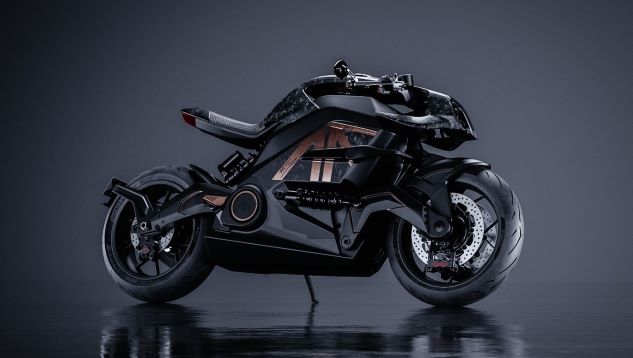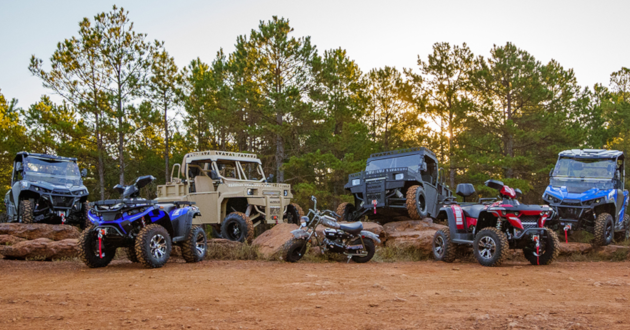Here’s a concept bike that’s for real
Honda’s 2004 Valkyrie Rune
When Honda’s R&D department asked the simple question,“What if,” the answer was the new 2004 Valkyrie Rune. Motorcycle enthusiasts can drool over a cool concept bike like the one from which the Rune was developed, but motorcycle engineers can take that emotion of envy one step further and actually make it happen.
After years of tooling around with concept ideas, one finally became reality when the 2004 Valkyrie Rune was introduced in June. The first of what will be an as yet undisclosed limited number of machines produced for the 2004 model year hits dealerships this month.
American Honda’s Manager of Motorcycle Press, Lee Edmunds, says most dealers probably already have a waiting list for the $27,000 custom since the bike will be in such short supply. “Each dealer will have the opportunity to order at least one unit,” says Edmunds.
He says the Rune is not for everyone, indicating that it’s difficult to pin down a certain buyer demographic for the mold-breaking bike since it’s so different from everything else. Edmunds predicts buyers will be, “… a discriminating enthusiast… with $27,000 in his pocket. This is not a bike for everyone. It will appeal to a select group of riders who want something that is unique and that you don’t see everyday.”
1832cc power plant
At the heart of this one-of-a-kind machine is an 1832cc six-cylinder engine that’s been hot-rodded to match the look and feel of the innovative and sleek design in which it’s seated.
The Rune boasts the longest wheelbase of any motorcycle in Honda’s history, at 68.9 inches, as well as the largest disc brakes fitted to a production Honda dual 330mm discs up front and a 336mm unit in back. The machine also has a seamless 6.2-gallon fuel tank, flush-mounted LED taillights and two handlebar options. There’s also a unique remote steering lock that unlocks automatically when the rider turns the key on. This fail-safe electronic interlock reduces the possibility of theft because the engine can only be started with the two original keys.
The Rune also features an innovative suspension set-up, a trailing bottom-link front fork and a Unit Pro-Link suspension system in the rear derived from Honda’s RC211V MotoGP bike. The Rune benefits from this type of rear suspension by not having a rear crossmember on the frame, allowing the seat to be slammed to a low 27.2 inches.
While the Valkyrie is credited by Honda for defining the “power cruiser,” the Rune takes that concept one step further, breaking all the rules in production capabilities. “We wanted to set the bar higher than ever, erecting standards that no one else had yet imagined, while also exploding old limitations on what an original equipment manufacturer could mass produce,” says Ray Blank, vice president of the motorcycle division at American Honda.
The Rune essentially shifted the development priorities on which the Honda name and reputation have been built. “It emphasized style rather than measurable science and engineering,” says Blank, “and that created challenges during product planning.”
historical perspective
To fully understand the concept of the Rune, one must look to the motorcycle’s roots. The spirit of the Rune is derived from a concept cruiser called the Zodia, revealed by Honda in 1995 at the Tokyo Motor Show. Some of the Zodia’s design elements, such as the trail-link front suspension and the single-side swingarm, are used in the Rune.
Honda’s engineers were then directed to come up with a series of concept bikes based on the GL six-cylinder engine. Of the four designs dubbed, T1, T2, T3, and T4, unveiled to the public at consumer shows over the next few years, the T2 stood out as a motorcycle people could envision themselves riding on the road. Honda executives felt public opinion was so strong that the company should build a bike exactly like the T2. Masanori Aori, the project leader on the Rune, had his doubts. “Are we really going to produce a motorcycle like this,” he recalls asking himself.
His thinking changed when he heard for himself the feedback from the public. “When I attended the Cycle World motorcycle show held in Long Beach (California) and saw the reaction from the customers on a first-hand basis, I completely grasped the concept.” He remembers one person even saying, “I will bring $30,000 in cash, so please sell it to me right away.”
a changing lineup?
“The Rune expands our production capabilities in yet another direction, blurring the line between concept and reality, and pushing our production capabilities to new levels,” says Blank. “In the end, that’s what makes the Rune unique beyond its elegant design and styling.”
In spite of the fact that the motorcycle will virtually sell itself, Honda plans a massive advertising campaign in the near future. Edmunds says the Rune is a brand-building motorcycle for the manufacturer. “Honda is positioning this bike as a limited edition, one-off custom that, incredibly, is made on a production line.”
A one-off custom with a price tag to match: A Rune with chrome wheels will run $26,999, while a Rune outfitted with “Spec47” silver wheels will cost $24,499. There are no accessories planned for the bike at this time.
Honda executives won’t reveal just yet what role the Rune will play in Honda’s overall lineup other than to say it is the newest member of the Valkyrie family. Whether the Rune will return in 2005 will depend on sales of this year’s model. Where does that put the Valkyrie as we know it? Plans have not yet been announced.
Maybe we should call upon the Rune itself for the answers as that is what the Vikings did long ago. Runes were the stones with which ancient Viking mystics used to predict the future.




